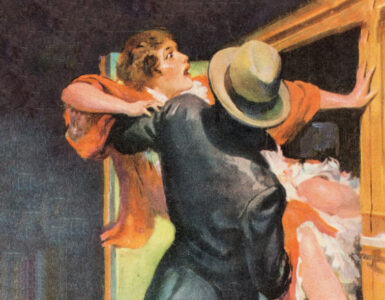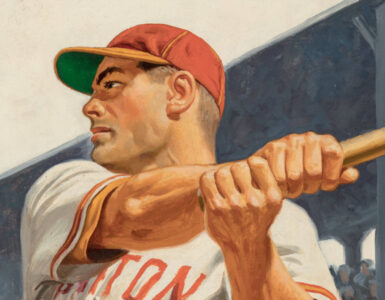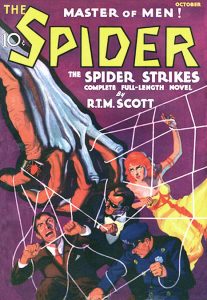 The pulp magazine was almost thirty-five years old when Walter Gibson, John Nanovic, and Frank Blackwell put together the first single-character pulp for Street & Smith. The brainchild of Henry W. Ralston, general manager of the well-established publishing firm, The Shadow, a Detective Magazine was an instant success. The first quarterly issue — dated April/May/June 1931 — was a sell-out. By the end of that first year, the magazine had become a monthly. Starting with the October 1, 1932 issue, The Shadow Magazine began appearing twice a month.
The pulp magazine was almost thirty-five years old when Walter Gibson, John Nanovic, and Frank Blackwell put together the first single-character pulp for Street & Smith. The brainchild of Henry W. Ralston, general manager of the well-established publishing firm, The Shadow, a Detective Magazine was an instant success. The first quarterly issue — dated April/May/June 1931 — was a sell-out. By the end of that first year, the magazine had become a monthly. Starting with the October 1, 1932 issue, The Shadow Magazine began appearing twice a month.
It didn’t take too long for the other publishers in the pulp market to notice the success of the new Street & Smith magazine. Within two years of that first quarterly issue, The Shadow Magazine had to face some competition for its readers’ small change.
Ned Pines’ Standard Magazines was first to enter the fray with The Phantom Detective, with its first issue dated February 1933. One month later, Street & Smith fought back with the first issue of Doc Savage, another instant hit. The publisher also revived its old dime novel detective, Nick Carter, as the hero of a pulp magazine. Popular Publications jumped into the ruckus toward the end of that year. G-8 and His Battle Aces and The Spider debuted with issues dated October 1933.
The most durable of Popular’s hero pulps was The Spider. In its initial run, Henry Steeger’s magazine lasted for 118 issues. The final issue of the pulp was dated December 1943. Even today, the series inspired by a large spider “on a tennis court” has proved remarkably resilient. To date, Steeger Books has published more than seventy stories from the original series in paperback, while contemporary authors such as Will Murray and Gary Phillips have written new adventures featuring “The Master of Men.”
The tremendous success of The Shadow Magazine was why Popular Publications turned to R. T. M. Scott to introduce their new character. Scott’s “Secret Service Smith” books were international bestsellers when the author was selected to initiate Popular’s new pulp series. Although Scott would only write the first two adventures in the series, his novels would serve as the template for the entire run of The Spider.
Popular’s publisher Henry Steeger laid out the basic concept behind the new series. According to the late pulp historian Robert Sampson:
The general idea of the series was that a wealthy young fellow would use an alternate identity to battle crime. . . . Wealthy young fellows had been doing this very thing, monthly, in popular magazines for an amazing number of decades. However, Steeger’s young man would be different. No 1920’s sentimentality would soften him. There would be no weak-milk business of shooting to wound. He would fight as if engaged in war. If the criminals deserved to die, die they would. Dime Detective had proved that readers snapped up stories of rolling violence, harsh with guns and horror.
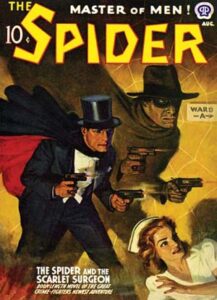 Although Steeger outlined the premise for Popular’s new hero, it was left to R. T. M. Scott to fill in the details.The author wasted little time establishing the background for the series.
Although Steeger outlined the premise for Popular’s new hero, it was left to R. T. M. Scott to fill in the details.The author wasted little time establishing the background for the series.
“I believe that the Spider is on this ship,” is the opening line of “The Spider Strikes,” published in the October 1933 number. By the end of the second chapter, Richard Wentworth, the Spider, has killed his first villain and marked him with his scarlet spider seal. As the fifth chapter closes, Wentworth has escaped from a jam involving New York’s Police Commissioner Stanley Kirkpatrick and that pesky spider seal. Soon thereafter, Kirkpatrick is unconscious, critically wounded by a bullet meant for Wentworth. The chase is on before forty pages have passed. Before the end of the story, Wentworth’s lovely fiancé, Nita Van Sloan is in the hands of the enemy, dangled before Wentworth to entrap the nemesis of crime.
After rescuing his beloved, Wentworth deals a violent, vengeful death to his enemy, another hallmark of the series.
Abruptly the man in the ragged coat rose to his feet. He bent and lifted the other man, kicking and wriggling, straight above his head. For an instant the wild, misshapen figure held the wriggling man aloft, then tossed him, screaming from the roof — to the police-cleared street below!
The first two novels of Popular Publications’ answer to The Shadow Magazine resemble the English thriller story that Edgar Wallace brought to perfection in the early twentieth century. There is little of the weird menace, science fiction, and action for which the magazine would become renowned. However, both “The Spider Strikes” and Scott’s second novel, “The Wheel of Death,” do an exemplary job establishing the characters that would populate the remaining adventures in the pulp series. All of the lead characters are present, including Nita, Wentworth’s devoted Hindu servant, Ram Singh, Ronald Jackson — a mere chauffeur in the early stories — Jenkyns, the butler, Ezra Brownlee — Wentworth’s former professor and gadget man — and Apollo, the wonder dog.
Although the sexual tension of the series could also be found in these first novels, it was left to the next Spider author, Norvell Page — writing as Grant Stockbridge — to explore that ground a bit more intimately.
Page’s first issue of The Spider, dated December 1933, quickly cast off the style of Scott. “Wings of the Black Death” features a villain who threatens to unleash the bubonic plague upon the citizens of New York City. Norvell Page didn’t mess around.
Scott’s characters are still present, but changed, some more than others. Perhaps the most drastic alteration is witnessed in Page’s treatment of Nita. In the first two novels, Wentworth’s fiancee is fainting and performing other acts typical of the thriller heroine. However, in “Wings of the Black Death,” darling Nita is spinning Immelmans in a dogfight over Manhattan. In later stories, Miss Van Sloan would don the Spider’s cloak and hat when her beloved Dick was unavailable for duty. No wonder the late mystery writer and pulp fan, Mike Avallone, fell big time for the woman.
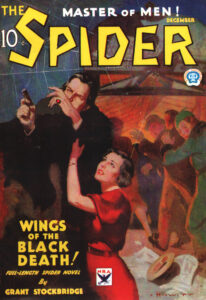 Norvell Wordsworth Page would write ninety-one lead novels for The Spider. In the opinion of most fans of the character, the author’s best work appeared between 1933 and 1936. It was during this period that Page developed his unique hero tale — a story that seemed more like an emotional experience than a plotted storyline. In these novels, suffering becomes a way of life for Wentworth and company. New York itself becomes a character more than a setting. And death and horror are lurking just around the corner. They are unusual stories — emotional roller coasters that examine the ideals of heroism, self-sacrifice, and true love — all garbed in titles like “The Citadel of Hell,” “Satan’s Death Blast,” “Hordes of the Red Butcher,” “Death Reign of the Vampire King,” “Legions of Madness,” and “Dragon Lord of the Underworld.”
Norvell Wordsworth Page would write ninety-one lead novels for The Spider. In the opinion of most fans of the character, the author’s best work appeared between 1933 and 1936. It was during this period that Page developed his unique hero tale — a story that seemed more like an emotional experience than a plotted storyline. In these novels, suffering becomes a way of life for Wentworth and company. New York itself becomes a character more than a setting. And death and horror are lurking just around the corner. They are unusual stories — emotional roller coasters that examine the ideals of heroism, self-sacrifice, and true love — all garbed in titles like “The Citadel of Hell,” “Satan’s Death Blast,” “Hordes of the Red Butcher,” “Death Reign of the Vampire King,” “Legions of Madness,” and “Dragon Lord of the Underworld.”
For almost ten years, The Spider appeared on newsstands each and every month. The magazines were gobbled up by young and old alike. The tales of Scott and Page and a trio of other writers helped the pulp’s adult readers escape from the dismal economics of The Great Depression and the horrors brought upon the world by fascism. For the younger set, the adventures of Wentworth as Tito Caliepi, Blinky McQuade, and Snuffer Dan Tewkes were more than enough to set their hearts afire. And beautiful Nita too, spinning Immelmans as if she had been taught to fly by G-8.
For more on The Spider, please visit our YouTube Channel for our videos on The Spider. You can catch our latest, Artists of The Spider, by clicking here. Created by PulpFest’s Sara Light-Waller, it looks at the work of the cover and interior artists for the Popular Publications’ hero pulp.
Other Spider videos on our YouTube channel include Craig McDonald’s The Spider: An Uncertain Face — which you’ll find here — and Craig’s fifth segment in his continuing series on “The Great Pulp Heroes.” While you’re visiting YouTube, please be sure to subscribe to the PulpFest Channel.
Our featured image was excerpted from Walter Baumhofer’s cover painting for the October 1933 issue of Popular Publications’ The Spider, the first issue of the long-running hero pulp magazine.
Richard Wentworth used the alternate identity of The Spider to battle crime in Depression-era America. Cover artist Rafael DeSoto rendered both Wentworth and his violent alter-ego on the magazine’s cover a number of times over the years. Pictured above is the artist’s cover for the August 1941 issue of The Spider, illustrating “The Spider and the Scarlet Surgeon.”
Norvell Wordsworth Page made his debut as Grant Stockbridge in the December 1933 issue of The Spider. The cover art is by John Newton Howitt, who painted nearly four dozen covers featuring “The Master of Man.” To learn more about John Newton Howitt, read “The Mystery and Mastery of John Newton Howitt,” featured on our site in July 2014.
Emile C. Tepperman, IV has been writing occasionally for our website since 2017. He is purportedly the great-grandson of pulp author Emile Clemens Tepperman, who is best remembered for the thirteen-part Purple Invasion series that he penned for Popular Publications’ Secret Service Operator #5. Tepperman also penned a dozen Spider adventures. A. H. Bittner and Prentice Winchell wrote the remaining stories in the series.


